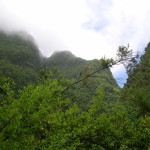It was last weekend, when I finally had the time and the right vehicle to take the bumpy drive up into the depths of the Parque Montecristo. This national reserve sits along the Northern border of El Salvador, where it famously meets two neighbours – Guatemala and Honduras. The mountain inside the park is called El Trifino, and in fact that is the only part which would be categorised as cloud forest. The rest is secondary pine forests, but beautiful just the same (for those non-scientists amongst you a secondary forest is one that has been cut down at least once and allowed to re-grow. The implications are that the biodiversity isn’t as high as a primary forest, which has escaped deforestation altogether). As we managed to scramble up the near vertical parts of the entry road, in a subaru forester, I wondered how three countries manage to club together to successfully manage a wildlife refuge. Well, the result seems to be a lot of strange rules. Firstly, you are not allowed into the park without a permit, applied for in advance. Secondly, you are not allowed to walk anywhere in the park, except on the specially designated footpaths. Thirdly you are not actually allowed in the cloud forest area at the moment, as it has been temporarily closed for ‘construction’ for two months. For construction? This forest has taken millions of years of evolution to be constructed, what can man possibly do to it in two months which will be of any benefit?
Having said all that, the park staff where enormously helpful and very professional, and as we were science educators we were allowed to wander a little ways into the cloud forest to have a look. This was a good cardiovascular workout, and as we saved our breath for respiration as we climbed, we fell instantly under the spell of the whispering quiet of the trees. I remembered taking a group of students from the ABC to Costa Rica for our first Environmental systems field trip there, and I was asked
“What is a cloud forest”, and “Do clouds grow up there?”
Well, a cloud forest is a tropical rainforest which grows at high altitude, basically at the altitude where clouds form. As clouds are basically floating water droplets, this means that a lot of the humidity which a rainforest requires comes in the form of misty water droplets, and not so much as falling rain. Cloud forests are a lot cooler than normal tropical rainforests, and are generally occur on the tops of mountains. What this means is that the staggering biodiversity of a rainforest in on display, but also for the casual walker or amateur biologist the climate is much fresher and more pleasant than a steamy lowland rainforest. Orchids abound, mammals tend to be a bit furrier in order to stay warm, and insects tend to be a little less murderous. And of course there are clouds, drifting through, bringing a certain mystical ambience – which combined with the spell-binding variety of nature cannot fail to delight those who seek out the quiet places of this Earth.
In other words, clouds forests are well recommended for rainforest beginners. Except the only one in El Salvador is closed right now, ‘under construction’. Now is that cloudy, or clear?






